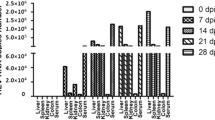Abstract
Tree shrews (Tupaia belangeri chinenesis) can be experimentally infected with human hepatitis B virus (HBV) by inoculation with human serum positive for HBV, the experimental infection rate being 55.21%. Successive infections have been passed through five generations among the tree shrews inoculated with HBV-positive sera from the infected animals, the average infection rate being 94.0%. The experimental infection of tree shrews with HBV may be prevented by immunization with hepatitis B vaccine, the protection rate being 88.89%. Standard serum containing HBV at 108 CID (chimpanzee infection dose)/ml, was diluted 10−6, 10−7, 10−8, 10−9, and 10−10 and produced infection rates of 80.0%, 88.8%, 66.7%, 55.6% and 42.9% respectively. Thus the CID50 in tree shrews may reach a dilution of 10−9, which shows that tree shrews are sensitive to HBV infection. These results successfully establish tree shrews as a reliable and useful animal model for research on HBV infection and its relation to hepatocarcinogenesis.
Similar content being viewed by others
Abbreviations
- HCC :
-
Hepatocellular carcinoma
- HBV :
-
human hepatitis B virus
References
Cova L, Wild CP, Mehrotra R, Turusov V, Shirai T, Lambert V, Jacquet C, Tomatis L, Trepo C, Montesano R (1990) Contribution of aflatoxin B1 and hepatitis B virus infection in the induction of liver tumors in ducks. Cancer Res 50: 2156–2163
Cova L, Mehrotra R, Wild CP, Chutimaewin S, Cao SF, Duflot A, Prace M, Yu SZ, Montesano R, Trepo C (1994) Duck hepatitis B virus infection, aflatoxin B1, and liver cancer in domestic Chinese ducks. Br J Cancer 69: 104–109
Cullen JM, Marion PL, Sherman GJ, Hong X, Newlold JE (1990) Hepatic neoplasms in aflatoxin B1-treated, congenital duck hepatitis B virus-infected, and virus-free Peking ducks. Cancer Res 50: 4072–4080
Darai G (1978) Experimental infection ofTupaia belangeri (tree shrews) with herpes simplex virus type I and II. Infect Dis 137: 211–236
Gerin JL (1990) Experimental WHV infection of woodchucks: an animal model of hepadnavirus-induced liver cancer. Gastroenterol Jpn 25 [Suppl 2]: 38–42
Kim CM, Koike K, Saito J, Miyamura T, Jay G (1991) HBx gene of hepatitis B virus induces liver cancer in transgenic mice. Nature 351: 317–320
Koike K (1993) Transgenic mouse model for hepatocellular carcinoma in human hepatitis B virus infection. Nippon Rinsho 51: 536–541
Marion PL, Van Davelaar MJ, Knight SS, Salazar FH, Garcia G, Popper H, Robinson WS (1986) Hepatocellular carcinoma in ground squirrels persistently infected with ground squirrel hepatitis virus. Proc Natl Acad Sci USA 83: 4543–4546
Merlino G (1994) Transgenic mice as models for tumorigenesis. Cancer Invest 12: 203–213
Pasquinelli C, Bhavani K, Chisari FV (1992) Multiple oncogenes and tumor suppressor genes are structurally and functionally intact during hepatocarcinogenesis in hepatitis B virus transgenic mice. Cancer Res 52: 2823–2829
Ponzetto A, Forzani B (1991) Animal models of hepatocellular carcinoma: hepadnavirus-induced liver cancer in woodchucks. Ital J Gastroenterol 23: 491–493
Popper H, Roth L, Purchell RH, Tennant BC, Gerin JL (1987) Hepatocarcinogenicity of the woodchuck hepatitis virus. Proc Natl Acad Sci USA 84: 866–870
Racela LS, Tegtmeier GE, Hodges GR, Reed JS (1986) Comparison of two testing methods to determine hepatitis B surface antibody response to hepatitis B vaccine among health-care workers. Am J Clin Pathol 86: 527–529
Reddy JK, Svoboda DJ, Rao MS (1976) Induction of liver tumors by aflatoxin B1 in the tree shrews (Tupaia glis), a nonhuman primate. Cancer Res 36: 151–160
Seawright AA, Snowden RT, Olubuyide JO (1993) A comparison of the effects of aflatoxin B1 on the livers of rats and duck hepatitis B virus-infected and noninfected ducks. Hepatology 18: 188–197
Sherker AH and Marion PL (1991) Hepadnavirus and hepatocellular carcinoma. Annu Rev Microbiol 45: 475–508
Wan BX, Liu JC, Xi OY, Zhang XS, Zhang SC, Wang ZM, Zhang WF, Xui WM, Wang FN, Ding XF (1982) Experimental study on the infection of adult tree shrew (Tupaia belangeri yunalis) with human rotavirus. Natl Med J Chin 62: 461–465
Wu XX, Tang EH, Xie GZ, Zhang XS, Xui WM, Lao QS, Liu MY, Wen YL, Zhu BC, Lu YJ (1983) Investigation on herpes virus of tree shrews. Chin J Micro Immunol 3: 33–36
Zan MY, Liu CB, Li CM, Zhang WY, Zhu C, Pang QF, Zhao TX, Wang G, Wang JL (1981) A preliminary study of hepatitis A virus infection in Chinese tupaia. Acta Acad Med Sin 3: 148–152
Author information
Authors and Affiliations
Rights and permissions
About this article
Cite this article
Yan, R.Q., Su, J.J., Huang, D.R. et al. Human hepatitis B virus and hepatocellular carcinoma I. Experimental infection of tree shrews with hepatitis B virus. J Cancer Res Clin Oncol 122, 283–288 (1996). https://doi.org/10.1007/BF01261404
Received:
Accepted:
Issue Date:
DOI: https://doi.org/10.1007/BF01261404




